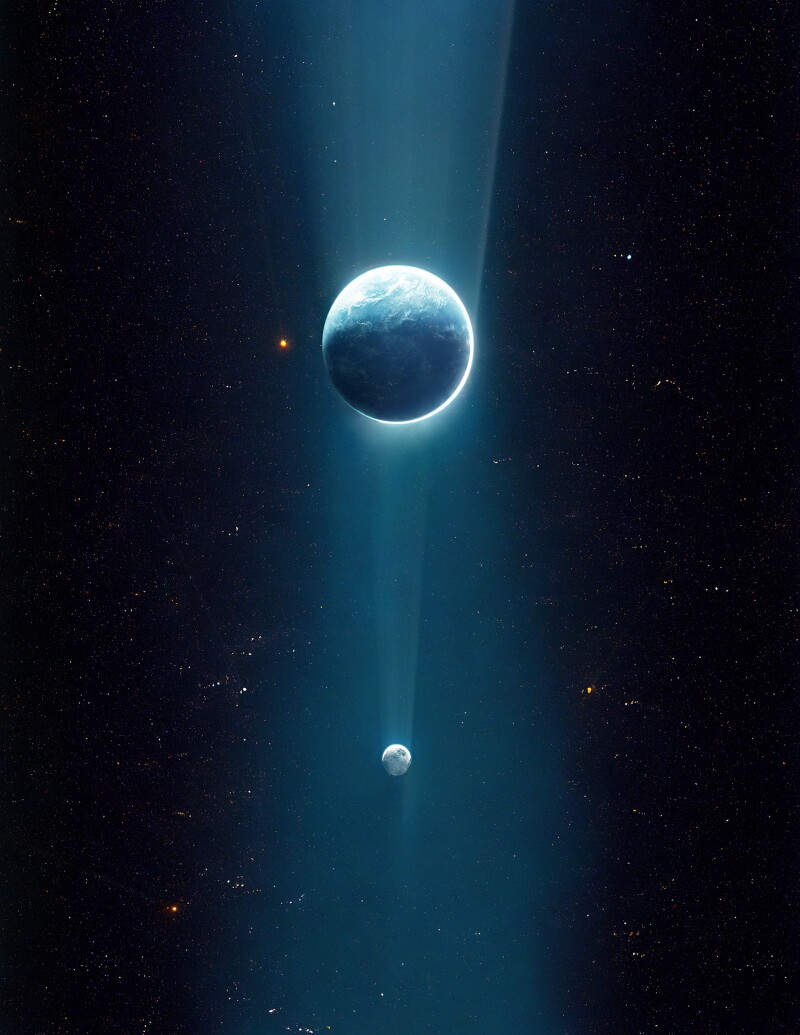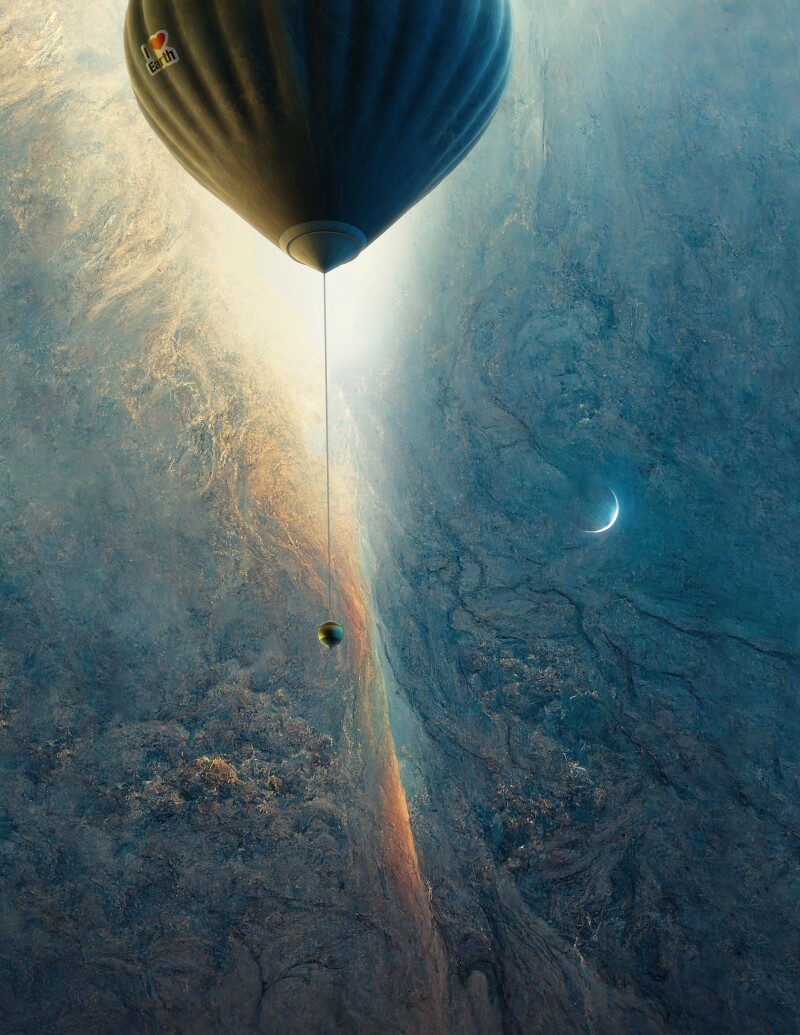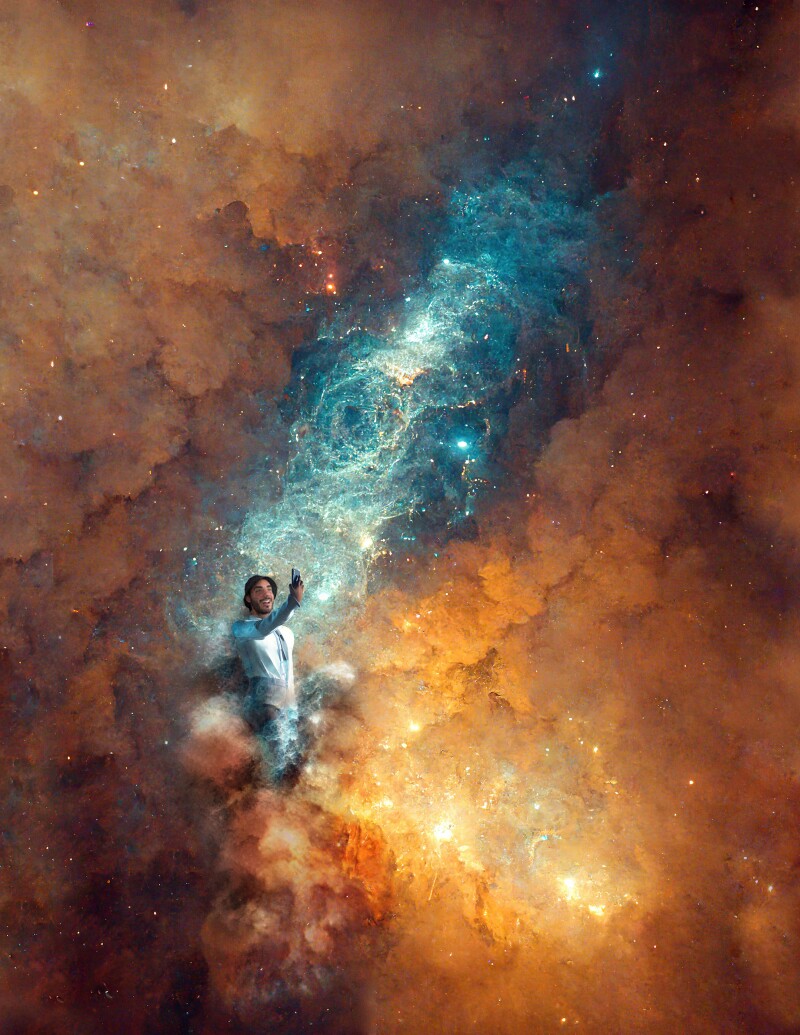It was a fine spring evening in New York City, and the Goldberg brothers were at an event to consider the proposition of traveling to space. They had tippled a few cocktails, their mood was convivial, and, from their posture of repose on the fifth floor of the private club Zero Bond, the notion sounded very tempting. “The idea of being able to see the world from afar is pretty interesting,” Eric Goldberg said. “I do think there is an appeal to it,” Mike agreed. “Going to space is fucking cool. I don’t want to sound obnoxious, but you can go to a lot of places on Earth—not everybody gets to go to space.”
It wasn’t just the exclusivity of space-going that enthralled them, though. The real allure was the possibility of transcendence. As though describing a hallucinogenic trip, the terms used by explorers and astronauts to recount reaching the limits of the atmosphere depict something like experiencing the sublime. “I floated out of my seat and over to the window, and there was the coast of Africa coming up over the horizon,” the former astronaut Jeffrey Hoffman told me by phone a few weeks after the Zero Bond event. “I saw the curvature of the Earth and the thin blue line of the atmosphere. You’re looking back at Earth from an environment that doesn’t support any life. That’s when I really started to appreciate how wonderful Earth is.”
What Hoffman described is what has been called the Overview Effect, a phenomenon chronicled by astronauts to describe a sudden sense of awe or divine recognition that they feel when they depart from the planet and then turn and look back at it: a lump of rock spinning through the universe distinguished by its protective shroud of exhalations—the cumulative effect of the living enabling life.

The Overview Effect can often inspire great awe—and dread—in people who experience it.
Illustration by Delcan & Co.
Teasing this kind of cognitive convulsion has become a key selling point in the growing space tourism industry, led by firms founded by Richard Branson, Jeff Bezos, and Elon Musk and joined by an ever-expanding number of smaller companies offering space experiences. “Will leaving Earth bring you closer to it?” asks a Virgin Galactic advertisement. Blue Origin declares on its website that the view of Earth from space is “life changing.” SpaceX quotes the late NASA astronaut Sally Ride saying her perspective on the planet from above made her appreciate the fragility of human life.
These three companies, founded by technologists with space ambitions that extend far beyond short commercial flights for tourists, have taken dozens of people to space in the past couple of years, spearheading what is forecast to be a $3 billion industry within the decade. In September 2021, the first all-civilian flight launched into orbit, followed by a Japanese billionaire’s self-funded trip to the International Space Station (ISS); the same billionaire contracted SpaceX for the first civilian moon mission, slated for 2023. Earlier this year, in April, a crew of wealthy businessmen also visited the ISS on a flight coordinated by SpaceX and another company, Axiom Space. Extrapolating from the ticket prices that have been made public, the average cost for these trips to the ISS is more than $50 million per passenger. Effectively, that makes visiting the ISS one of the most exclusive journeys available.
There are cheaper options for obtaining the Overview Effect, including staying in suborbital flight. (Orbital flights, like those to the ISS, reach velocities that allow them to escape the gravitational pull of the planet and encircle it; suborbital flights, like those proffered by Blue Origin and Virgin Galactic, reach space for a few moments, then return to Earth.) But the Goldbergs were at Zero Bond to consider a third option, established by two of the original members of the eight-person crew that inhabited Biosphere 2, a fantastical 1990s project to advance space travel by creating a closed ecological system in the Arizona desert.
Space Perspective, founded in 2019 by wife-and-husband duo Jane Poynter and Taber MacCallum, offers flights in a capsule attached to a hydrogen balloon that are set to launch in 2024. The balloon ascends to a height of 20 miles above the planet, far short of the 62-mile-high Kármán line, recognized by the Fédération Aéronautique Internationale as the boundary between Earth’s atmosphere and space, but high enough to see partial curvature, when the Earth’s horizon begins to reveal its roundness. It is billed as the first luxury spaceflight experience. The deep leather seats, soft lighting, and immaculately polite bartender at Zero Bond were no accident—they gestured at the kind of adventure Space Perspective intends to offer. This is an image of space travel not as a spartan excursion into a pitiless void but as a kind of transcendental cocktail party in the sky.

Space Perspective offers aspiring space travelers a less environmentally taxing way to travel to the stars.
Illustration by Delcan & Co.
As a carbon-neutral company requiring almost none of the fossil fuels for its trips that rocket launchers rely on, Space Perspective promises something else, too: exoneration from the sticky moral problems most commonly associated with space tourism. A rocket launch can burn 11,000 gallons of fossil fuel per second during liftoff, and a space shuttle takes around eight and a half minutes to reach orbit. Between the environmental cost and the astronomical price of a ticket—set against the backdrop of planetary climate breakdown and the erosion of basic social protections—some of the civilians paying millions to rocket into space over the past year haven’t seemed much like travelers in search of sublimity; to people like the Goldbergs, they’ve seemed treacherously out of touch. Instead of a spiritual seeker on a righteous quest for nirvana, a certain kind of space tourist has appeared more like a modern-day Orpheus, who, in the instant that he peers behind him for reassurance from the most beautiful sight imaginable, dooms himself to live without it for eternity.
Jane Poynter, 60, still believes in the transformative power of sending civilians to space, even if she’s trying to do things a little differently. Before her event at Zero Bond, I met her at the Rose Center for Earth and Space at the American Museum of Natural History on Manhattan’s Upper West Side, where, instead of looking at simulations of planets, we sat on a bench in the dark and talked in too loud-for-museum voices about the urge to go to space. Poynter was 29 when she sealed herself inside Biosphere 2 for two years to see whether the ecosystem she and others had built, with financing from the nephew of a Texas oil tycoon, could sustain human life. The experiment proved fraught, weighted by the scope of its own ambition, but Poynter and her crewmates saw their mission through, despite hunger and oxygen deprivation.
While living in Biosphere 2, Poynter started the Paragon Space Development Corporation, her first space exploration company, with MacCallum and a third collaborator, Grant Anderson. The trio and their researchers at the company developed life support tools and other systems for NASA; they also advised Elon Musk while he was establishing SpaceX. In 2011, Poynter and MacCallum were contacted by a Google engineer named Alan Eustace who wanted to break the record for the world’s highest skydive. Along with two other parties, they created a space suit that would replace the need for a pressurized capsule—which skydivers who jump from great heights often use for the ride up—and sent Eustace to a record-breaking altitude of 135,890 feet using an age-old technology: a balloon.
That became the seed of a company called World View, founded by Poynter and MacCallum, which promised to take tourists to the edge of space via balloon. Those journeys never materialized, and Poynter and MacCallum eventually left World View and started Space Perspective three years ago. Poynter sees the company’s mission as one that is in step with the other spacefaring ventures: to make the experience of visiting space accessible to more people, whether they’re in it for the Overview Effect, for the exclusivity, to live out astronaut fantasies, or to be part of something that feels like the future. “Here’s the way to think about space travel,” she told me. “Aviation, in the beginning, was for wealthy people and governments. Now, people rely on it for delivery, for bringing the family closer—it’s affecting so much of our lives. The same will be true of space travel.”
This is an image of space travel not as a spartan excursion into a pitiless void but as a kind of transcendental cocktail party in the sky.
Using balloons to reach such heights isn’t unprecedented. Aeronauts—the balloon-piloting explorers of the late 19th and early 20th centuries—became heroes (or they perished) as they traveled to elevations unknown to science; in 1862, two British aeronauts reached an estimated 37,000 feet, the upper end of a modern airplane’s cruising altitude, to help advance studies on the atmosphere. MacCallum’s father, an astrophysicist, used balloons to send telescopes to space—one of the precedents that prompted MacCallum and Poynter to explore the same technology for Eustace’s flight and then for Space Perspective. Today, balloons are deployed without human passengers to gather meteorological data and to study the effects of radiation on equipment and astronauts. NASA has had an office devoted to ballooning for more than 30 years.
One of Space Perspective’s main talking points is that the history of ballooning and the frequency of scientific telescope and other research launches show that the technology is established, making it a safe way to travel to space. Many research balloons use light gases like hydrogen and helium, leaving an opening at the bottom for excess to escape and allowing them to reach higher altitudes than traditional hot-air balloons. The research balloons can reach roughly 22 miles above the Earth, expanding to the size of a football stadium when fully inflated, large enough to contain the Statue of Liberty. This will also be the case with the Space Perspective balloons—buoyed primarily by hydrogen, due to a worldwide helium shortage—that lift its passenger capsules. (Hydrogen also powered the infamous Hindenburg airship, but as Poynter is quick to point out, that vessel wasn’t a balloon.) Since the flights won’t reach zero gravity, passengers won’t need training or specialized gear such as helmets or oxygen masks, and they’ll be able to walk around the capsule after liftoff.

Ascending to the edge of space can take up to two hours by balloon.
Illustration by Delcan & Co.
But high-altitude ballooning is still new in the field of passenger travel, and a balloon on a test flight for World View exploded during liftoff in 2017. (No one was seriously injured.) Poynter believes that the method is safe, with built-in redundancies, and Space Perspective isn’t the only company trying to develop the technology; its competitors include World View and EOS-X Space, a European space ballooning company. If anything, the trips are designed to be the opposite of fear inducing: Passengers will ascend slowly for two hours, spend another two hours hovering over Florida and the Bahamas (where they can look down and see the thin blue line of the atmosphere and the waters of the Atlantic), and descend for a final two hours before splashing down in the Gulf of Mexico. “We’re so used to thinking of spaceflight as high g’s, space suits, and the uncomfortable white utilitarian interiors of the capsule, and we said, ‘To hell with all of that,’” Poynter told the crowd at Zero Bond. “This technology allows us to offer this incredibly gentle flight. You go into space at 12 miles an hour; it’s silent when it launches. It’s graceful.”
Operating out of the Kennedy Space Center in Florida, Poynter and her team developed the 200-square-foot vessel—a prototype has already been sent on unmanned test journeys—intended to capture this new vision of a space experience, with configurable seating facing nearly floor-length windows. In renderings, tropical fronds and tiny herb gardens are interspersed among deep lounge chairs outfitted with drink trays. Martini shakers sit next to champagne chilling in a bucket of ice.
A few months before their second round of fundraising, which pulled in $17 million last May after an initial round had raised more than $40 million, Space Perspective announced that Miami restaurateur David Grutman would consult on its hospitality experience. Poynter describes each flight as bespoke to the preferences of the eight passengers on board, with menus, music, and lighting customized to specific tastes. At $125,000 per ticket for a six-hour flight, the price is clearly geared toward a certain clientele, but the cost is significantly less than flying with Blue Origin or SpaceX. And even though few people I spoke with at the Zero Bond event left committed to Space Perspective that evening, enthusiasm is there: As of August 2022, almost 900 tickets for flights have been purchased. Poynter and MacCallum soon noticed that half the tickets sold were to groups that booked the entire capsule, which is when they realized that whatever kind of experience nosing toward outer space may be, it’s one that people want to share.

Space Perspective is seeking to make the experience of traveling to space less of a grueling one and more a celebratory occasion.
Illustration by Delcan & Co.
Whether the great undertaking of space travel for its metaphysical revelations can outweigh its material waste is a question of how to measure purpose. There are no hard statistics on the degree to which people who experience the Overview Effect become committed environmentalists, and it certainly isn’t clear whether a lifetime of environmental advocacy can compensate for the emissions of some spaceflights. That’s obviously not the point of missions operated by astronauts who are seeking to gather data and expand humanity’s understanding of the universe. But for many of the multiplying number of journeys to space that are tailored to transport a tourist, the meaning of these flights is measured in large part by personal and existential transformation.
Dr. Deana Weibel, a cultural anthropologist and professor at Michigan’s Grand Valley State University who has studied the effect of space travel and the ways it is described—often in religious terms—has observed that the people drawn to space exploration often understand their lives to be part of a greater destiny. For those to whom space travel is important, tourism may be a poor term to capture what might be better called a pilgrimage.
“In Islam and Christianity and to some extent Judaism, there is an association between God and the heavens, with there being things like angels above us,” Weibel told me when we spoke by phone in mid-July. “There’s this idea of a great large power, and whether you’re speaking in religious terms or astronomical or astrophysics terms, it’s up there. And maybe you can understand it better if you go there.”
Famously, actor William Shatner told Jeff Bezos after a trip on a Blue Origin flight that seeing space was like seeing death. “There’s the blue down there, and the black up there. . . . Is that death? Is that the way death is?” Shatner said. Viewing the thinness of the atmosphere protecting life on Earth against the vastness of the universe, Shatner was struck by how fragile a sheath constitutes the difference between human existence and the lack of it.
If space tourism flourishes, the shape that it takes will determine the contours of life to come. Space Perspective and other ballooning operations—as well as companies such as Blue Origin using alternative fuel, and VR startups trying to re-create the Overview Effect without any travel at all—seem to thread the needle between accounting for the consequences of space travel and making the sublime attainable.

Could traveling to the edge of space help humanity better understand the delicate balance of life on earth?
Illustration by Delcan & Co.
Poynter believes she felt this wonder during her two years in Biosphere 2. “We had the most extraordinary experience of really understanding what it is to live in a finite place,” she told me. “We could see the edges of our world, and we were breathing the same oxygen. Our CO2 was making the plants around us. . . . There was this incredible chemical dance that was going on, clearly embedded in our biosphere.”
In her Space Perspective pitch, Poynter talks about this recognition often, citing the shift that was transformational in her own life, even though it was very much of this planet. It might be strikingly palpable to voyagers 20 miles above the surface of the Earth, but Poynter found it on Earth, too, just 30 miles outside of Tucson, Arizona, down a winding road in the Sonoran Desert, underneath a ragged shard of mountains that turns purple on those evenings when the sinking sun sets the sky on fire.











